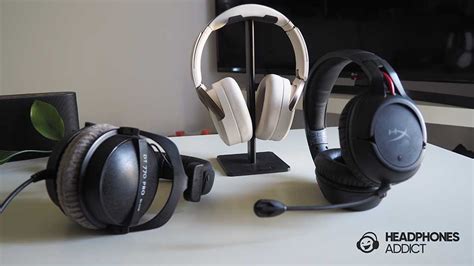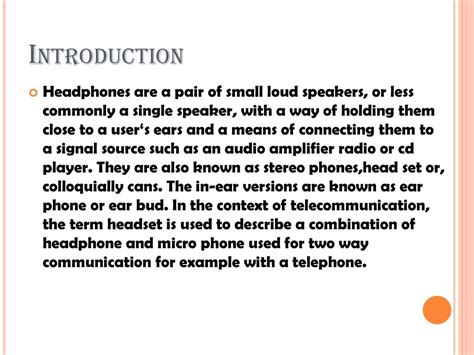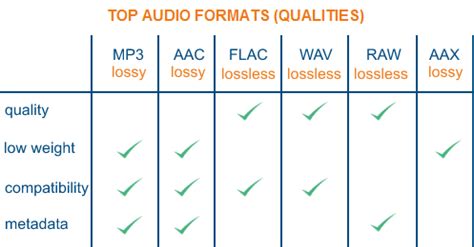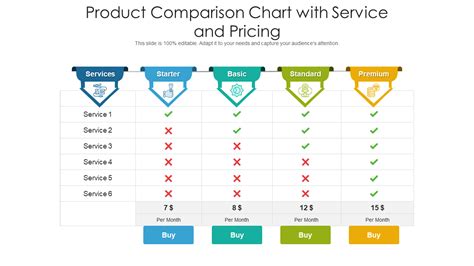Imagine stepping into a world of pure acoustical bliss, where your favorite tunes and audio marvels envelop your senses. As the melodies resonate through your being, you may have often pondered the differences between two crucial companions in your sonic journey: headsets and headphones.
With their ubiquitous presence in our daily lives, it becomes imperative to appreciate the unique qualities that set headsets and headphones apart. Both of these auditory marvels are designed to facilitate an immersive audio experience, but their divergent features cater to distinct auditory requirements.
Exploring the depths of these audio companions, we embark on an enlightening voyage that delves into their dissimilarities. While they may appear synonymous at first glance, their functions, designs, and applications portray a contrasting landscape that needs to be meticulously dissected.
Headset vs. Headphones: Key Differences Explained

When it comes to audio devices, it's important to understand the distinctions between a headset and headphones. These two terms often confuse people, but they possess unique features and serve different purposes. In this section, we will delve into the primary contrasts between headsets and headphones, offering insights into their design, functionality, and usage.
| Headset | Headphones |
|---|---|
Headsets are audio devices that provide both headphones and a microphone in one unit. They are commonly used in various settings, such as gaming, communication, and professional environments. With a built-in microphone, headsets allow users to communicate through voice calls, online gaming, or video conferences, making them an ideal choice for individuals who need both audio output and input capabilities. In addition to the microphone, headsets often come with features like volume controls, mute buttons, and adjustable headbands, providing a comprehensive communication solution. | Headphones, on the other hand, refer to audio devices that focus solely on delivering high-quality sound output. They are primarily designed for recreational purposes, such as listening to music, watching movies, or immersing oneself in virtual reality experiences. Unlike headsets, headphones do not come with a built-in microphone, which makes them less suitable for activities that require voice communication. However, headphones often excel in terms of audio performance, offering superior sound quality and more detailed acoustics. Furthermore, headphones come in various designs such as over-ear, on-ear, and in-ear, allowing users to choose the style that best suits their preferences and comfort. |
So, when it comes down to it, the key difference between headsets and headphones lies in their functionality and purpose. Headsets cater to individuals who require both audio input and output capabilities, making them ideal for activities that involve communication. On the other hand, headphones focus solely on delivering exceptional sound quality, making them perfect for recreational purposes where voice communication is not a priority. Understanding these distinctions will help you make an informed decision when choosing the right audio device for your specific needs.
Understanding Headsets: Unveiling the Essence of this Audio Device
Headsets, synonymous with headphones, have become an integral part of our daily lives. These audio devices offer a compelling way to enjoy music, communication, gaming, and more, all with the added convenience of hands-free functionality. In this section, we will delve into the concept of a headset and explore its distinctive features and functionalities.
| Feature | Description |
| Audio Output | Headsets are equipped with speakers or earbuds that deliver high-quality sound directly to the user's ears. |
| Microphone | Unlike headphones, headsets are equipped with an integrated microphone that enables two-way communication, making them ideal for hands-free conversations, online gaming, and voice recognition. |
| Connectivity | Headsets can connect to devices through various means, including wired connections such as 3.5mm audio jacks or wireless technologies like Bluetooth. |
| Controls | Most headsets feature built-in controls that allow users to adjust volume, answer calls, play/pause music, and navigate through audio tracks or virtual environments. |
| Comfort | Headsets are designed with user comfort in mind, often incorporating features such as adjustable headbands, cushioned ear cups, and lightweight materials. |
Whether you are an avid music lover, a professional needing clear communication, or a gamer seeking immersive experiences, a headset offers a versatile audio solution. Its combination of headphones and a microphone elevates the user experience to another level, enhancing both audio output and input capabilities. By understanding the essence of headsets, you can make informed choices when selecting the perfect device for your needs.
Introduction to Headphones

In this section, we will explore the concept of headphones and discuss their features and functionality. We will delve into the world of personal audio devices that allow users to enjoy their favorite music, movies, and more, in a private and immersive way.
| Key Points |
|---|
| 1. Definition of headphones |
| 2. Types of headphones |
| 3. Components and design features |
Headphones are an essential accessory in today's digital age, offering a personalized audio experience. They provide a means of listening to audio content without disturbing others and allow individuals to immerse themselves in their own private world of sound. With various options available, it is crucial to understand the different types and components of headphones to make an informed choice based on individual preferences and requirements.
When it comes to types of headphones, there is a wide range to choose from, including over-ear, on-ear, in-ear, and wireless options. Each type offers its own unique advantages and caters to specific needs, whether it be comfort, portability, or audio quality. Additionally, headphones come equipped with various components such as drivers, ear cushions, headbands, and controls, all contributing to the overall performance and user experience.
Understanding the various components and design features of headphones is essential for determining their overall quality. Factors such as driver size and type, impedance, frequency response, and noise isolation capabilities play a significant role in the audio output and user satisfaction. By considering these aspects, individuals can choose headphones that meet their desired audio standards and preferences.
Now that we have introduced the concept of headphones and highlighted their importance in personal audio, let us dive deeper into each type of headphones, examining their unique characteristics and capabilities. By doing so, we can gain a comprehensive understanding of these devices and make well-informed decisions when it comes to choosing the right pair of headphones for our needs.
Functionality and Design: How They Differ
In this section, we will explore the unique characteristics and features that distinguish the functionality and design of headsets and headphones. Although both devices serve the purpose of delivering audio, they differ in various aspects that cater to different user preferences and needs.
| Functionality | Design |
|---|---|
When it comes to functionality, headsets are distinct from headphones in terms of their additional capabilities. Headsets are typically equipped with a built-in microphone, allowing users to communicate verbally while enjoying audio content. This makes headsets a preferred choice for activities such as gaming, video conferencing, and voice recording. On the other hand, headphones focus primarily on delivering high-quality sound, making them ideal for music listening and immersive media experiences. They are designed to provide superior audio performance and noise isolation, ensuring crystal-clear sound reproduction. Moreover, some headsets offer features like noise-canceling technology, which actively reduces external noise for enhanced audio quality during communications. This functionality is not commonly found in headphones, as they prioritize sound accuracy over noise cancellation. | While both headsets and headphones come in various designs, they differ in terms of form factor and aesthetics. Headsets typically feature a design that incorporates both headphones and a microphone, with the latter attached to the headset strap or connected via a flexible boom arm. This design ensures easy access to the microphone for clear communication, without the need for an external microphone setup. In contrast, headphones are usually designed as standalone audio devices, focusing on comfort and portability. They come in different sizes and styles, including over-ear, on-ear, and in-ear options. Their sleek and compact designs make them ideal for everyday use, allowing users to enjoy high-quality sound anytime, anywhere. Additionally, headphones often prioritize aesthetic appeal, offering various color options and premium materials like leather and metal for a stylish and sophisticated look. This attention to design ensures that headphones not only deliver exceptional audio but also complement the user's personal style. |
Overall, the functionality and design of headsets and headphones vary to cater to different audio needs and preferences. Understanding the distinctions between these devices can help individuals choose the most suitable option for their specific requirements, whether it be for gaming, communication, music enjoyment, or simply expressing personal style.
Sound Quality: Which is Better?

When it comes to audio devices, the sound quality is a crucial factor that can greatly enhance the overall listening experience. In this section, we will explore and compare the sound quality of headsets and headphones, focusing on their respective strengths and weaknesses in delivering immersive and high-fidelity audio.
Headsets: Headsets, also known as headphones with built-in microphones, are designed for users who require both audio output and input capabilities. The integration of a microphone allows for hands-free communication, making headsets a popular choice for gamers, call center agents, and individuals who frequently engage in phone conversations or virtual meetings. Despite the added functionality, the sound quality of headsets can sometimes be compromised due to the emphasis placed on microphone performance.
Headphones: On the other hand, headphones are solely dedicated to delivering exceptional audio quality. With no built-in microphone, they can purely focus on optimizing sound reproduction, resulting in a more refined and immersive listening experience. The absence of a microphone also allows for a more spacious design, enabling the headphones to accommodate larger and more powerful drivers, resulting in a wider frequency response range and improved overall sound quality.
Overall, when it comes to sound quality, headphones tend to have an edge over headsets due to their exclusive focus on audio reproduction. However, it is important to consider the intended usage and personal preferences, as headsets are tailored to specific needs such as communication while providing decent sound quality.
Uses and Applications: When to Choose a Headset or Headphones
When it comes to audio devices, it's crucial to understand the various uses and applications of headsets and headphones. Utilizing the appropriate device can greatly enhance your audio experience and cater to specific needs and preferences. Whether you're an avid music lover, a busy professional, or a gamer, selecting the right equipment can make all the difference.
- Music Enthusiasts: If you are passionate about music and enjoy immersing yourself in the intricacies of every beat and melody, headphones are the ideal choice. Their ability to provide high-quality sound reproduction allows for a more detailed and accurate listening experience. You can fully appreciate the nuances and dynamics of different genres and enjoy your favorite tracks to the fullest.
- Professional Use: In a professional setting, such as call centers or customer service roles, a headset becomes an essential tool. The key advantage of a headset is its built-in microphone, enabling clear and hands-free communication. Headsets also offer better comfort during extended periods of use, thanks to their ergonomic design, adjustable headbands, and cushioned ear cups. They provide a seamless solution for conducting business calls, attending virtual meetings, or engaging in online conferences.
- Gaming Experience: Gamers often require a device that offers both excellent sound quality and clear voice communication options. In this case, a headset with surround sound capabilities and a noise-canceling microphone is the optimal choice. These features provide an immersive gaming experience, allowing you to hear every footstep, explosion, or dialogue with precision, while also enabling clear and uninterrupted communication with teammates during multiplayer sessions.
- Portability and Convenience: If portability and convenience are your primary concerns, headphones are the way to go. Their compact and lightweight design makes them easy to carry and wear on the go, be it during travel or while commuting. They are also compatible with a wide range of devices, including smartphones, tablets, laptops, and music players, making them a versatile option for daily use.
By thoroughly considering the uses and applications of headsets and headphones, you can make an informed choice based on your specific requirements. Whether you crave superior audio quality, hands-free communication, immersive gaming, or portability, there is an ideal option available to enhance your audio experience.
Price Range: Comparing the Costs

In this section, we will explore the different price ranges available when considering purchasing either a headset or a pair of headphones. We will delve into the various factors that can affect the cost of these audio devices, allowing you to make an informed decision based on your budget and requirements.
- Entry-level options
- Mid-range selections
- High-end choices
- Add-ons and accessories
- Considerations for purchase
For those seeking affordable audio solutions, there are entry-level options available in both the headset and headphone categories. These options are often characterized by their budget-friendly prices, making them suitable for those on a tight budget or newcomers to the audio world.
If you are willing to invest a bit more in audio quality and features, the mid-range selections might be the perfect fit for you. These options offer a balance between price and performance, providing better sound quality and additional features compared to their entry-level counterparts.
For audio enthusiasts or professionals who prioritize top-notch sound quality, there are high-end options available at a higher price point. These choices often incorporate advanced technologies, premium materials, and intricate designs to deliver an exceptional audio experience. While they may be more expensive, they offer unparalleled audio performance and durability.
In addition to the core headset or headphone device, there are various add-ons and accessories available that can affect the overall cost. These include features like noise-canceling capabilities, wireless connectivity, customizable settings, and branded collaborations. Considering these add-ons can further impact the price range within each category.
When comparing the costs of headsets and headphones, it is important to consider your specific needs and preferences. Determine factors such as the intended usage, desired features, and budget limitations. By evaluating these aspects, you can select a device that offers the best value for your money.
Headphone Buying Guide | Consumer Reports
Headphone Buying Guide | Consumer Reports by Consumer Reports 15,311 views 2 years ago 3 minutes, 58 seconds
FAQ
What is the difference between a headset and headphones?
A headset is a combination of headphones and a microphone, while headphones are just audio devices that you wear on your ears to listen to music or other audio.
Are headsets more expensive than headphones?
Not necessarily. The price of headsets and headphones can vary depending on the brand, quality, and additional features. However, headsets generally tend to be more expensive than headphones due to the added microphone functionality.
Can I use headphones with a built-in microphone as a headset?
Yes, headphones with a built-in microphone can be used as a headset. The microphone allows you to make or receive phone calls, use voice chat during gaming, or participate in online meetings.




